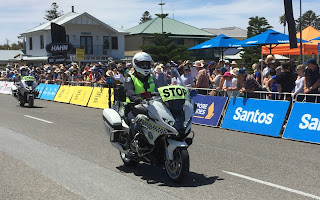For cycling fans only.
The Tour Down Under 2024 came to the Fleurieu Peninsula today. It began at Murray Bridge, designed to focus attention on, and support, the rebuilding of the town after the terrible damage done when the Murray River flooded last year. A lovely visual beginning to the race. (These photos were taken from the TV hence their not-so-great quality - but it was great to see them ride over the bridge in the neutral stage.)


 |
| And off through the town of Murray Bridge. |
 |
| Staying glued to the screen. |
My friend Sandy and I had arranged to go together to Port Elliot to watch the finish of the race. Her husband Lester generously offered to drive and drop us off to avoid parking worries. We arrived almost two and a half hours earlier, but we were prepared with stools, snacks and sunscreen. Being so early we had the choice of a prime spot and duly positioned ourselves not far from the finish line. Gradually the crowds began to gather - eating, drinking, chatting, and generally preparing themselves for the 'big moment' when the riders would whizz past. There was a buzzy feeling.
I loved the way the town was so enthusiastically behind the event and there were lots of decorations along the route such as these knitted masterpieces.
I settled in.
We were listening to the commentary and watching the race on a big screen so we knew where the riders were. Evidently they were going so fast they would be here sooner than expected. Yay. Meanwhile the sponsors' cars (known as the 'cavalcade') came into view with their hilarious papier maché figures atop the cars.
 |
Love the cycling kangaroo.
|
The sponsors' people jumped out and handed out little 'gifts' (no doubt tax deductible) to all the people lining the roadside near the finish line. We were given caps, water bottles, lip balm, fans, and best of all... a cow bell. Sandy took this clever photo of me getting practice in ringing it.
The sponsors' cars are moved on ...
... and then the police make sure the road is clear.
And then ... the helicopter is sighted. The riders are coming.
The commentators are ratcheting up the tempo as they announce that the riders are in fact turning onto The Strand - the finishing 500 metres. We spectators are beside ourselves. Cowbells and cameras at the ready. This next photo was taken by
Darren Weinert a fellow member of Steve's camera club. Yes ... I am aware that this is the best photo in the blog!!!!! Thanks Darren.
And here the leaders come. They are travelling at least 50kph.
We're ringing our cow bells, thumping the barriers, cheering and yelling.
 |
The winner is Australian Sam Welsford.
Here he is in a blur just about to cross the line. |
And here is the bunch that couldn't catch him. Only seconds away but seconds count!
And more of the peleton follow.
Many of the riders in this Tour are young and fairly new to world class racing. A lot of the big names stay away at this time of the year, preparing themselves for the European races. So I knew hardly any of them. But it was good to see new young faces with their lively attitude, energy and ambitions.
You can just see the ocean in the background in this next photo.
This posture says it all.
We stayed to watch the presentation. Here Isaac Del Torro (a Mexican) receives the leader's ochre jersey.
One last look at Horseshoe Bay (which is behind this presentation structure).
My final photo is of my friend Sandy who, I realised later, I did not take one photo of! Thanks Sandy for your company. What a day. Here she is as we wait to be picked up again by Lester.









































































